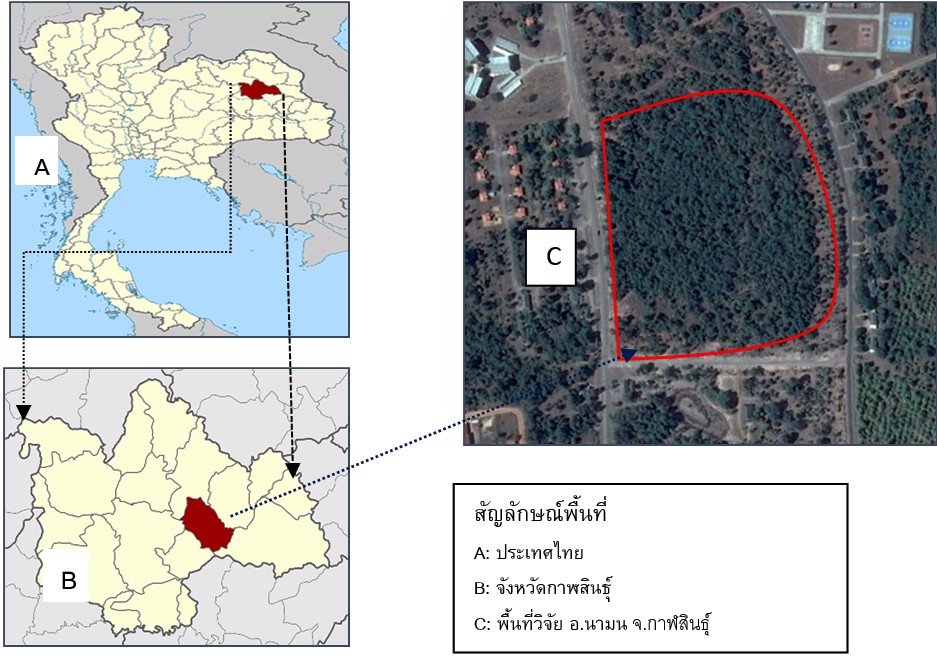มวลชีวภาพและการกักเก็บคาร์บอนของต้นไม้ในพื้นที่โครงการอนุรักษ์พันธุกรรมพืชและคืนสัตว์สู่ป่าในมหาวิทยาลัยกาฬสินธุ์ (พื้นที่นามน)
Main Article Content
Abstract
Sorasak Temwut and Tunwa Chaitieng
รับบทความ: 6 มิถุนายน 2563; แก้ไขบทความ: 9 ธันวาคม 2564; ยอมรับตีพิมพ์: 5 มกราคม 2564; ตีพิมพ์ออนไลน์: 5 มิถุนายน 2564
บทคัดย่อ
ปริมาณแก๊สคาร์บอนไดออกไซด์ในชั้นบรรยากาศเป็นสาเหตุสำคัญที่ทำให้เกิดภาวะเรือนกระจก แต่ป่าไม้มีบทบาทสำคัญในการลดแก๊สคาร์บอนไดออกไซด์ในอากาศได้ งานวิจัยนี้มีวัตถุประสงค์เพื่อศึกษาปริมาณมวลชีวภาพ การกักเก็บคาร์บอน และการดูดซับคาร์บอนไดออกไซด์ของไม้ยืนต้น ในพื้นที่โครงการอนุรักษ์พันธุกรรมพืชและคืนสัตว์สู่ป่ามหาวิทยาลัยกาฬสินธุ์ โดยทำการวางแปลงศึกษา ขนาด 10×10 เมตร จำนวน 56 แปลง โดยการวางแปลงอย่างเป็นระบบ วัดขนาดของไม้ยืนต้นที่มีความสูง 1.30 เมตร และเส้นผ่าศูนย์กลางระดับอก 4.50 เซนติเมตรขึ้นไป วิเคราะห์มวลชีวภาพได้จากสมการแอลโลเมตรีที่พัฒนาขึ้นโดย Ogawa. et al. (1965). วิเคราะห์หาการกักเก็บคาร์บอนได้จากมวลชีวภาพ และวิเคราะห์หาการดูดซับคาร์บอนไดออกไซด์ได้จากการกักเก็บคาร์บอน ผลการศึกษาพบว่าลักษณะสังคมป่าในพื้นที่ศึกษาเป็นป่าเบญจพรรณ พบไม้เด่น เช่น ไม้ประดู่ ไม้แดง และมีพันธุ์ไม้ที่พบในแปลงตัวอย่าง 26.ชนิด 16 วงศ์ 26 สกุล มีปริมาณมวลชีวภาพรวม เท่ากับ 12,375.43 กิโลกรัมต่อไร ปริมาณการกักเก็บคาร์บอนรวม เท่ากับ 6,187.72 กิโลกรัมคาร์บอนต่อไร่ และปริมาณการดูดซับคาร์บอนไดออกไซด์ของไม้ยืนต้น เท่ากับ 22,708.92 กิโลกรัมคาร์บอนไดออกไซด์ต่อไร่ พื้นที่โครงการอนุรักษ์พันธุกรรมพืชและคืนสัตว์สู่ป่าในมหาวิทยาลัยกาฬสินธุ์ ควรได้ถูกสนับสนุนให้มีการอนุรักษ์และคงไว้ซึ่งระบบนิเวศของป่า และควรมีการเสนอให้พื้นที่ชุมชนต่าง ๆ ทั่วประเทศให้มีการอนุรักษ์ป่าไม้สืบต่อไป
คำสำคัญ: มวลชีวภาพ การกักเก็บคาร์บอน ป่าอนุรักษ์
Abstract
The amount of carbon dioxide in the atmosphere is a major cause of Greenhouse effect, but forests play an important role in reducing carbon dioxide in the air. This research aimed to study the amount of total biomass, carbon sequestration and carbon dioxide ab-sorption of trees in the plant genetic conservation and return animals to the wild area of Kalasin University. This study was conducted by setting up the 10×10 m2 total of 56 plots by using line plot system method. The process is recording the DBH (diameter at breast height), the height as well as for plant species list and plant family list of trees (DBH >4.5 cm and height >1.30 m) then calculated the biomass by using the allometry equation, which developed by Ogawa, et al. (1965). The estimating of carbon stock was converted by a conversion factor as 0.5 of bio-mass and carbon dioxide absorption multiplied by a conversion factor as 3.67 of carbon stock.
Keywords: Biomass, Carbon stock, Preserved forest
Downloads
Article Details

This work is licensed under a Creative Commons Attribution-NonCommercial 4.0 International License.
References
Anthakhek, T. (2019). Biodiversity of Amphibians and Reptiles in the Area of Plant Genetic Conservation and Returning Animals to the Forest in Plant Genetic Conservation and Return Animals to the Wild Area of Kalasin University. Bachelor of Environmental science Thesis, Kalasin: Kalasin University. (in Thai)
Duangthip, N., Kaiwijit, P and Pampasit, S. (2016). The carbon storage in protection area of plant genetic conservation project under the Royal Initiation of Her Royal Highness Princess Maha Chakri Sirindhorn (RSPG) at Sirikit Dam, Uttaradit province. Proceeding Research and Activity; The 12th Naresuan Research: Research and Innovation and National Development. Pitsanulok: Naresuan University. (in Thai)
Dugchalerm,S., Duangsathaporn K., and Prasomsin, P. (2014). A study on forest in-ventory techniques for non–timber forest products (NTFPS) inventory in Ban Chong Khaeb Samakkhi community forest, Sai Yok district, Kanchanaburi province. Journal of Forest Management 8(16): 1–15. (in Thai)
Cairns, M. A., Brown, S., Helmer, E. H., and Baumgardner, G. A. (1997). Root biomass allocation in the world’s upland forests. Oecologia 111(1): 1–11.
Haghdoost, N., Akbarinia, M., and Hosseini, S. M. (2013). Land–use change and carbon stocks: A case study, Noor County, Iran. Journal of forestry research 24(3): 461–469.
Hengpraprom, S. (2009). Global warming and infectious diseases. Research of Public Health System Journal 3(3): 363–369. (in Thai)
Horn, H. S. (1975). Forest succession. Scientific American 232(5): 90–101.
Girma, A., Soromessa, T., and Bekele, T. (2014). Forest carbon stocks in woody plants of Mount Zequalla Monastery and it’s variation along altitudinal gradient: Implication of managing forests for climate change mitigation. Science, Technology and Arts Research Journal 3(2): 132–140.
Intergovernmental Panel on Climate Change (IPCC). (2017) .Climate Change 2007: Synthesis Report. Retrieved from: https://www.ipcc.ch/report/ar4/syr/, November 2, 2017.
Kutintara, U. (1999). Ecology fundamental basics in forestry. Bangkok: Faculty of Forestry. Kasetsart University. (in Thai)
Nuanurai, N. (2005). Comparison of Leaf Area Index, Above–ground Biomass and Car-bon Sequestration of Forest Ecosystems by Forest Inventory and Remote Sensing at National Park, Thailand. Master of Science Thesis (Zoology). Bangkok: Chulalongkorn University. (in Thai)
Ogawa, H., Yoda, K., Ogino, K., and Kira, T. (1965). Comparative ecological studies on three main types of forest vegetation in Thailand II. Plant biomass. Nature and Life in Southeast Asia 4: 49–80.
Ounkerd, K., Sunthornhao, P., and Puangchit, L. (2016). Valuation of carbon stock in trees at Khao Wong community forest, Chaiyaphum province. Thai Journal of Forestry 34 (1): 29–38. (in Thai)
Pumijumnong, N. (2007) Aboveground–root biomass and soil carbon content of teak plantation. Environment and Natural Resources Journal (5)2: 109–121. (in Thai)
Temchai, T., and Kaewket, C. (2013, January). The long age of forest ecology in national park: Permanent conversion network in tropical mixed deciduous forest, Chaloem Phrakiat Natural Park of Rachaburi province. Proceeding Research and Activity; in 2nd Academic Conference of the Thai Forest Ecology Research. Chi-ang Mai: Mae Jo University. (in Thai)
The Chaipattana Foundation. (2020). Theory of Forest rehabilitation due to Royal Initiative. Retrieved from https://www.chaipat.or.th/site_content/item/254-theory-developed-forest-restoration.html, December 20, 2019.
Viriyabuncha, C. (2003). Handbook of Stand Biomass Estimation. Forestry and Botanical Research Division Department of National Parks, Wildlife and Plant Conservation. (in Thai)
Wacharakitit, S., and Sangauntham, P. (1983). Forest land use and production study of Phu Luang forest. Thai Journal of Forest 2(2): 223–248.
Zhu, X. G., Long, S. P., and Ort, D. R. (2008). What is the maximum efficiency with which photosynthesis can convert solar energy into biomass? Current Opinion in Biotechnology 19(2): 153–159.
